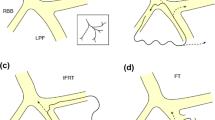Summary
The impulse conduction in the left ventricle is maintained by two subdivisions of the left bundle branch, the left anterior and posterior fascicle. The classification of intraventricular conduction disturbances may be extended by the knowledge that the left fascicular blocks are recognizable by typical changes of the main frontal QRS axis: The two hemiblocks can be added to the typical left and right bundle branch block patterns. They occur alone or in combination with each other.
A case is described of a permanent complete right bundle branch block and an alternating impulse conduction in the two left fascicles. At any time, only one fascicle was able to conduct. Before permanent pacemaker implantation the patient experienced Adams-Stokes attacks. It can be presumed that the remaining and still conducting fascicle was temporarily blocked, too, which is interpreted as an intermittent complete bilateral bundle branch block or more precisely an intermittent trifascicular block.
The above described electrocardiographic pattern has rarely been observed. So far, 10 cases were published in the world literature.
Zusammenfassung
Die Erregungsübertragung auf den linken Ventrikel erfolgt über zwei Hauptäste des linken Tawaraschenkels, den linken anterioren und den linken posterioren Ast. Mit der Erkenntnis, daß die Astblockierungen an typischen Einstellungen des größten QRS-Vektors in der Frontalebene erkennbar sein können, erfährt die Einteilung der intraventrikulären Leitungsstörung eine Erweiterung: neben das typische Rechts- und Linksschenkelblockbild treten die beiden Astblockbilder allein und in Kombination.
Es wird ein Fall beschrieben, bei dem der rechte Schenkel permanent komplett blockiert ist, während die Erregungsleitung in den beiden linken Ästen alterniert. Es ist jeweils nur ein einzelner Ast leitfähig. Da das Krankheitsbild vor der Schrittmacherimplantation mit einem Adams-Stokes-Syndrom einherging, war offensichtlich zeitweilig auch der letzte noch leitende Ast blockiert, d. h., es lag ein intermittierender kompletter doppelseitiger Schenkelblock, und zwar ein sicherer trifaszikulärer Block vor.
Die genannte Kombination ist bis jetzt nur selten beobachtet worden. Es sind erst 10 Fälle im Weltschrifttum mitgeteilt.
Similar content being viewed by others
Literatur
Katz, L. N., Hamburger, W. W., Rubinfeld, S. H.: Partial bundle branch block. Amer. Heart J.7, 753 (1932).
Lepeschkin, E.: The electrocardiographic diagnosis of bilateral bundle branch block in relation to heart block. Progr. cardiovasc. Dis.6, 445 (1964).
Spang, K.: Rhythmusstörungen des Herzens, S. 235. Stuttgart; G. Thieme, 1957.
Holzmann, M.: Ungewöhnliche EKG-Befunde bei einem Fall von AV-Block und wechselseitigem Schenkelblock. Cardiologia (Basel)23, 116 (1953).
Uhley, H. N., Rivkin, L. N.: Visualization of the left branch of the human atrioventricular bundle. Circulation20, 419 (1959).
Spack, M. S., Huang, S., Armstrong, S. J., Canent, R. V.: Demonstration of the peripheral conduction system in human hearts. Circulation28, 333 (1963).
Lev, M.: Anatomic basis for atrioventricular block. Amer. J. Med.37, 742 (1964).
Tawara, S.: Das Reizleitungssystem des Säugetierherzens. Jena: G. Fischer 1906.
Eppinger, H., Rothberger, C. J.: Über die Folgen der Durchschneidung der Tawaraschen Schenkel des Reizleitungssystems. Z. klin. Med.70, 1 (1910).
Rothberger, C. J., Winterberg, H.: Experimentelle Beiträge zur Kenntnis der Reizleitungsstörungen in den Kammern des Säugetierherzens. Z. ges. exp. Med.5, 264 (1917).
Uhley, H. N., Rivkin, L.: Electrocardiographic pattern following interruption of the main and peripheral branches in the canine left bundle of His. Amer. J. Cardiol.13, 41 (1964).
Watt, T. B., Freud, G. E., Durrer, D., Pruitt, R. D.: Left anterior arborization block combined with right bundle branch block in canine and primate hearts. Circulat. Res.22, 57 (1968).
Wigle, E. D., Chrysohon, A., Bigelow, W. G.: Results of ventriculomyotomy in muscular subaortic stenosis. Amer. J. Cardiol.11, 572 (1963).
Grant, R. P.: Left axis deviation, an electrocardiographic-pathologic correlation study. Circulation14, 233 (1956).
Pryor, R., Blount, S. G. Jr.: The clinical significance of true left axis deviation. Amer. Heart J.72, 391 (1966).
Rosenbaum, M. B., Elizari, M. V., Lazzari, J. O., Nau, G. J., Levi, R. J., Halpern, M. S.: Intraventricular trifascicular blocks. The syndrome of right bundle branch block with intermittend left anterior and posterior hemiblock. Amer. Heart J.78, 306 (1969).
Rosenbaum, M. B., Elizari, M. V., Lazzari, J. O., Nau, G. J., Levi, R. J., Halpern, M. S.: Intraventricular trifascicular blocks. Review of the literature and classification. Amer. Heart J.78, 450 (1969).
Strauss, S., Langendorf, R.: Bilateral partial bundle branch block. Amer. J. med. Sci.205, 233 (1943).
Winterberg, H.: Beitrag zur Kenntnis der Störungen in der Reizübertragung des menschlichen Herzens und der Anfälle bei Adams-Stokesschem Symptomenkomplex. Z. ges. exp. Med.8, 131 (1919).
Grassberger, A.: Klinische, elektrokardiographische und histologische Untersuchungen eines Falles mit Adams-Stokes-Erkrankung. Z. klin. Med.112, 388 (1930).
Spang, K.: Herzblock mit Morgagnis-Adams-Stokesschen Anfällen und Cheyne-Stokes-artigen Atemstörungen. Dtsch. Arch. klin. Med.190, 457 (1943).
Stein, G.: Zur Differentialdiagnose des doppelseitigen Schenkelblocks. Z. Kreisl.-Forsch.47, 140 (1958).
Damato, N. A., Lau, S. H., Helfant, R. H., Stein, E., Berkowitz, W. D., Cohen, S. I.: Study of atrioventricular conduction in man using electrode catheter recordings of His bundle activity. Circulation35, 287 (1969).
Schloff, L. D., Adler, L., Donoso, E., Friedberg, C. H.: Bilateral bundle branch block: clinical and electrocardiographic aspects. Circulation35, 790 (1967).
Dressler, W., Jonas, S.: Experimental production of A-V dissociation with ventricular captures by use of an internal pacemaker in patients with 2:1 A-V block. Amer. J. Cardiol.10, 547 (1962).
Schamroth, L.: Principles governing 2:1 A-V block with interference dissociation. Brit. Heart J.31, 780 (1969).
Seipel, L., Gleichmann, U., Loogen, F.: Das elektrokardiographische Bild des Rechtsschenkelblockes mit intermittierendem links-anteriorem und links-posteriorem Hemiblock (intraventrikulärer trifaszikulärer Block). Z. Kreisl.-Forsch.61, 234 (1972).
Author information
Authors and Affiliations
Rights and permissions
About this article
Cite this article
Fleischmann, D., Effert, S. & Bleifeld, W. Trifaszikulärer Herzblock. Klin Wochenschr 51, 541–548 (1973). https://doi.org/10.1007/BF01482467
Issue Date:
DOI: https://doi.org/10.1007/BF01482467
Key words
- Trifascicular block
- left divisional block
- hemiblock
- bilateral bundle branch block
- Adams-Stokes syndrome
- Av-block




